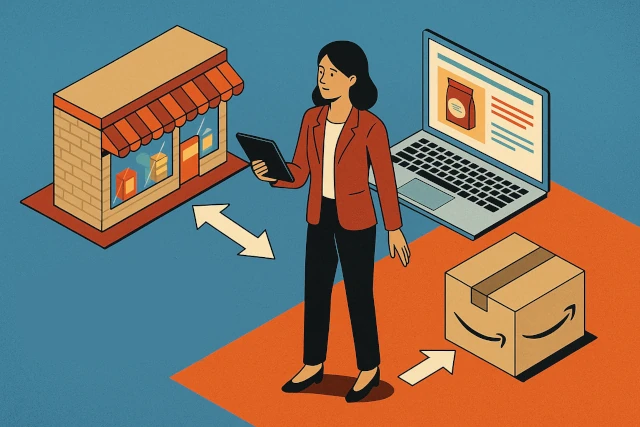What Does ‘Omnichannel Strategy’ Actually Mean for a <$5M Brand?

Introduction: Omnichannel Without the Overwhelm
When you read most articles about omnichannel strategy, you’d think every brand has a 50-person marketing team, seven-figure ad budgets, and a national retail footprint. But what if you’re running a lean CPG brand doing under $5M in revenue? Maybe your team is just you, a co-founder, a broker, and a few freelancers. You’re juggling DTC orders, fielding retail interest, considering Amazon, and trying to grow without burning out—or burning through your runway.
This article is your no-BS guide to building a realistic, focused omnichannel strategy that works at the scrappy growth stage. I’ll cover how to think about retail, DTC, and Amazon—not as competing channels, but as synergistic ones. The goal is to grow velocity, margin, and brand equity, without spreading yourself too thin or torching cash on tactics that don’t scale.
What *Is* Omnichannel, Really?
Let’s be clear: omnichannel doesn’t mean “be everywhere.” It means showing up where your customers are, in a way that feels seamless and reinforces your brand. For a lean brand, this means choosing a few key channels that work together to build awareness, drive trial, and convert repeat purchases.
The big three channels you’re likely considering are:
- Retail (natural, conventional, independents)
- Direct-to-Consumer (DTC) via your website
- Amazon (and maybe other marketplaces)
Let’s break down how to make each of these channels work—together and independently—without burning cash or your sanity.
Retail: Still King for Trial and Trust
Retail is often the first meaningful growth channel for emerging food brands. A well-placed endcap or shelf spot can drive huge trial and brand awareness. But it’s also expensive: slotting fees, free fills, promos, broker commissions—it adds up fast.
How to Do Retail Right at <$5M:
- Start local and build a “proof-of-concept” region—e.g., 20-40 doors where you can support velocity and gather data.
- Use field marketing and demos judiciously—not everywhere, but in high-opportunity doors with good foot traffic.
- Focus on strong broker/distributor relationships that bring you warm introductions—not just slotting forms.
- Build strong buyer rapport. Answer their emails. Help them look good internally with clean decks and sales numbers.
- Don’t chase every chain. Some regional or independent accounts pull better than major banners with terrible support.
DTC: Your Learning Lab and Highest-Margin Channel
Your website is where you test pricing, learn what copy converts, and build a direct relationship with your customer. But paid acquisition is expensive—and getting worse. That means your DTC channel needs to be smart, not bloated.
How to Win at DTC with a Lean Team:
- Use DTC to test new SKUs, bundle offers, and messaging.
- Lean into organic and owned: email, SMS, UGC, and community over Meta ads (unless CAC is <50% of AOV).
- Run DTC campaigns that boost other channels—e.g., launch on your site, then drive into retail with a “Now at Whole Foods!” follow-up.
- Use DTC for gift boxes, samplers, and LTOs that don’t make sense for retail shelves.
- Collect first-party data like emails, reviews, preferences—this powers every other channel.
Amazon: The Necessary Evil (Or Secret Weapon)
Amazon can feel like a race to the bottom. But it’s also where many consumers start their product searches. If you’re not there, you’re invisible. But don’t treat Amazon like your core DTC site. It’s a utility channel: great for replenishment, Prime loyalty, and product discovery.
How to Approach Amazon Strategically:
- Use it as a conversion tool—not a brand builder. Customers may first see you on Instagram, but they’ll reorder on Amazon.
- Optimize for keywords, reviews, and product page conversion. Invest in great photos and A+ content.
- Start with just a few SKUs. Test pricing parity with your site (don’t compete against yourself).
- Monitor reseller activity like a hawk. Consider enrolling in Brand Registry and going FBM before jumping to FBA.
Which Channels Actually Work Together?
Here’s the dirty little secret: omnichannel synergy isn’t about showing up in all places at once. It’s about layering the right touchpoints to reinforce brand presence without duplicating effort or undercutting margins.
Most Effective Combinations:
- Retail + Amazon: Great for awareness and convenience. People discover you in stores, then reorder on Prime.
- DTC + Retail: Launch SKUs DTC, gather proof, then pitch retail with data. Offer store locators and retail campaign tie-ins on your site.
- DTC + Amazon: Use your site for bundling, sampling, and storytelling; use Amazon for repeat orders and Prime loyalty.
What to Avoid at This Stage
- Don’t try to scale all three channels at once. Nail one first, then layer in the others.
- Don’t over-invest in paid ads without LTV data. If you can’t recoup CAC in the first or second order, you’re just burning cash.
- Don’t chase channel expansion if your ops can’t handle it. Going from 20 stores to 200 with poor logistics will destroy your brand experience.
- Don’t ignore margin implications. Each channel takes a slice—plan your pricing architecture to preserve net profit.
How to Choose Your Next Move
If you’re doing under $5M, your omnichannel strategy should be about focus and sequence. Ask yourself:
- Where do my ideal customers naturally shop?
- Which channel gives me the highest ROI with the least team lift?
- Where can I gather the most actionable data to improve my offer?
- How can each channel support—not compete with—the others?
Your strategy should evolve quarter by quarter, not year by year. Start small. Prove what works. Then double down.
Conclusion: Omnichannel Is a Mindset, Not a Mandate
You don’t need to be everywhere. You need to be in the right places—with the right message, margin, and mechanisms to support your customer journey. Think of omnichannel as a toolbox, not a to-do list.
At the <$5M stage, focus is your greatest advantage. Stay scrappy, test smartly, and grow sustainably. That’s what real omnichannel looks like when you’re in the trenches—not in a boardroom.











